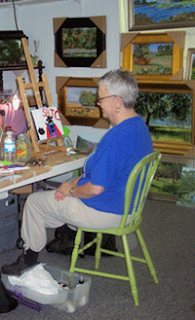 Where did you learn your technique?
Where did you learn your technique?(My first) teacher Dale, actually a potter rather than a painter, was pitching in for someone else. Dale pretty much let us splash paint around as we saw fit, and, in that process, I discovered that I always chose bright colors and created “primitive” images (probably because I couldn’t draw worth a hoot). Dale concluded that what I was doing looked somewhat similar to paintings from his friend Mike Segal (Cedar Key), so Dale brought in one of Mike’s pieces and suggested that I try to emulate it. That’s how the bright colors/primitive images part began. A class member brought in a photocopy of a stick-figured cow, saying she thought it looked like the subject matter I seemed to like to paint. Thus, the cows started mooing to me.
In more recent years, I’ve become friends with Mike and his wife Marvi. Although he probably internally cringes when I re-tell him the Dale/Mike/bright colors/primitive story and claim that he’s my (unauthorized) mentor, Mike is always very patient (well, as patient as Mike can stand to be) and has encouraged the development of my style. We end up in some of the same art shows, such as Thornbrook and Tioga. He wins the prizes and the big bucks, of course, while I look longingly in his booth’s direction, thinking, someday . . . .
After the beginning painters class, I took a couple of acrylic painting lessons with Elizabeth Barakah Hodges, another character in her own right. One time, I had the privilege of being her sole student for an evening. She introduced me to using collage with acrylic and, so, opened up another avenue for me.
I found out about Linda Pence’s watercolor classes, and thought that maybe I should learn a softer touch. It didn’t work. Even in the painting exercises, my work was always “Bold” and “Graphic” instead of subtle and delicate. Pence, being very wise and also quite flexible, didn’t try to change my bold color/primitive style. She just tried to sneak in some lessons on basic stroke work, mixing colors, thinking about composition, and stuff like that—you know, more the fine-tuning kinds of things.
We’ve become friends, and whenever I can, I take her workshops, sneaking in my acrylics among the watercolorists. Everyone is always friendly—in fact, when my son (only 33) died in June 2008—these wonderful people were the ones who made me an art sympathy card, and who donated money to the Artisans’ Guild where, after he had moved to Gainesville in 2007, he had shown/sold his exquisite Damascus-steel knives and jewelry.
Somewhere along the way, I also had the good fortune of hooking up with landscape artist extraordinaire Linda Blondheim. Going to her once-a-month open studio workshops has boosted my self-esteem as well as my skills. As with Pence, Blondheim has never tried to eradicate my style. She simply wanders around the studio, spending quality time with each (sometimes only two to five people) student, studying the painting in progress, asking questions, and making suggestions. Occasionally she hires me to write press releases for her, too.
Friendships with Blondheim and with her students in these studio visits have also helped me in my grief journey. To honor my son (who attended a couple of the open studio sessions with me and, although color blind, painted a respectable still life that Blondheim generously varnished and framed for me after his death), I’ve been writing and illustrating a children’s book on organ donation/transplantation. A couple of months ago, two of the studio artists listened as I sobbed my way through reading the draft and showing the images. Both offered excellent advice for continuation of my project and helped me feel comfortable after having shown my grief so openly.
Picture credit: "Loov-zies" , watercolor on paper



















